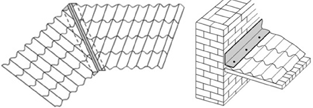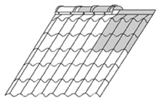
Gardenroof
Description Gardenroof
- Waterproof
- Easy to apply: the modules can be fixed with simple nails
- Lightweight: a sheet of 1150 x 680 x 4 mm weighs just 3.5 kg
- Resistant to cold (from -40 to +90 °C): do not crack or break after exposure to winter temperatures
- It does not rot
- Long lasting (at least 20 years)
- Modular: the available elements allow to realize different shapes and extensions
- Easy to cut: the tile sheets can be cut with a knife or a cutter
- Economic: both in the realization of the roof and in its maintenance
- Tile sheet: 1150 x 680 x 4 mm dimensions
- Ridge: 750 x 5 mm dimensions
- Transitional element from the roof tile to the ridge: 890 x 680 x 4 mm dimensions
- Angular: 1200 x 4 mm dimensions
- Stoppers (plugs)
Gardenroof tiles are an innovative solution compared to traditional roofing techniques. They are made of recycled material and are available in modular and lightweight elements, they are also characterized by a low cost and a need for almost non-existent maintenance.
Gardenroof is the ideal solution for do-it-yourself and for the construction of small roofs, but can also be used for roofing homes and warehouses. Examples of applications are: houses, gazebos, canopies, wooden houses, pergolas, etc.
Advantages
Available elements
Technical Specifications Gardenroof
- Large sheet roof tile (1150 x 680 x 4 mm): roof surface x 1.85 = total number of large roof tile sheets needed
- Small sheet roof tile (790 x 680 x 4 mm): roof surface x 2.80 = total number of small roof tile sheets needed
- Real ridges length (660 mm): total ridge length / 0.66 = total number of necessary ridges
- Tile-ridge transition elements: total number "runway" x 2.4 = total number of tile-ridge transition elements
- Real angular length (1150 mm): total duct length / 1,15 = total number of angles required
Property
Unit of measure
Value
Norm
Thickness
mm
3,0 - 4,0
Air mass
kg/m2
4
UNI EN 1849-2
Dimensional longitudinal stability (?L)
%
±0,3 %
±0,3 %
Dimensional transversal stability (?T)
%
±0,3 %
UNI EN 1107-2
Hardness
shore A
40
ASTM D 2240 - 05
Effort at break
MPa
3,2 ± 0,4
ASTM D 638 - IV
Elongation at break
%
54,5 ± 11
ASTM D 638 - IV
Tear resistance
N/mm
16
ASTM D 624 - 00
Watertightness
Waterproof
UNI EN 1928
Number of elements necessary to create a roof
Installation Gardenroof
Fixing of the Gardenroof tiles is done in the middle of the bottom of the wave, in correspondence of the transversal overlap by means of nails or screws of a length not less than 50 mm. In the middle of the sheet an additional fixing can be made on three other points of the wave. At the customer's request, decorative dowels (plugs) can be supplied to cover the head of the screw or nail.

Fixing of the tiles longitudinally takes place after their partial overlap by means of long nails or screws (70-90 mm). Fixing must also be carried out on the outside and in the corners.

Corner elements can be used for the joining of two sloping roofs to form a gutter

Fixing with a nail or screw already wraps the capsules (plugs) in contact with the roof surface: the material is resilient and provides a close connection with the fasteners.
